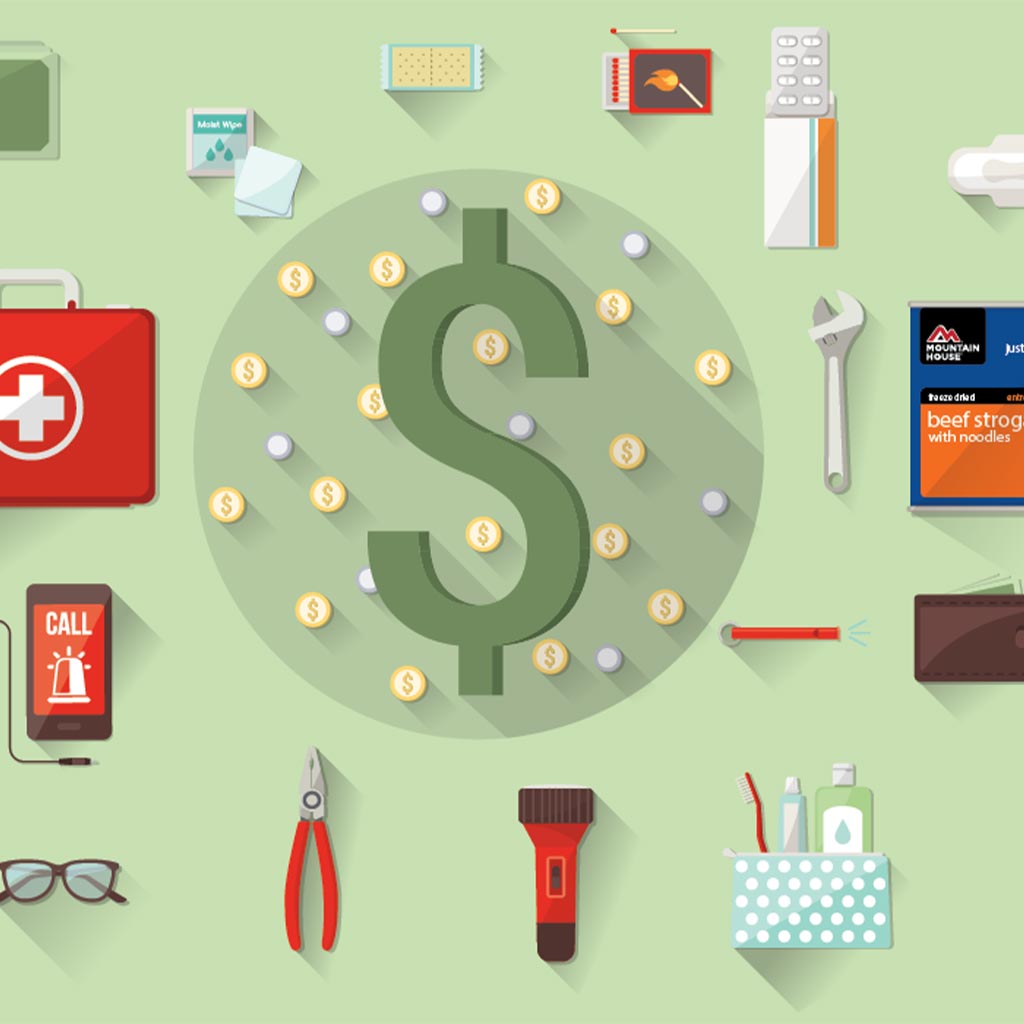Inspired for an Adventure? Check out Beef Stroganoff - Pouch and Beef Stew - Pouch
Free Ground Shipping On All Orders
Over 2,100 Reviews
Add description, images, menus and links to your mega menu
A column with no settings can be used as a spacer
Link to your collections, sales and even external links
Add up to five columns
Add description, images, menus and links to your mega menu
A column with no settings can be used as a spacer
Link to your collections, sales and even external links
Add up to five columns


Maybe you want to ready yourself for a potential natural disaster or other unpredictable emergency, but you worry that gathering the necessary supplies will be too expensive. Indeed, more than a quarter of households responding to a 2011 survey by the Federal Emergency Management Agency (FEMA) complained that prepping was prohibitively pricey. When you’re staring down bills, grocery lists, a car making less-than-encouraging noises, and other everyday budget concerns that seem a heck of a lot more in-your-face than some hypothetical hurricane or earthquake or alien takeover, it’s easy to write off emergency prepping as a luxury. Here’s the deal, though: Emergency preparedness doesn’t have to break the bank. We’re going to run down some tips for budget-conscious prepping in this blogpost, but at the outset a little perspective’s probably in order. So, two points to keep in mind when weighing the cost of disaster readiness: (1) A life-upending contingency can happen to absolutely anybody, it’s just part of the deal in our stormy, restless, volatile, and increasingly tech-dependent world. You can go about your life ignoring that reality, and maybe you'll never get in trouble. But even something as mundane as a grid malfunction can result in several days (or longer) of not being able to cook on your stove, or draw water from your tap, or combat the cold of a winter’s night with a simple crank of the thermostat. Not a time to play the odds. So consider a modest investment in emergency preparedness as a completely sound and practical investment: a form of insurance in an uncertain universe. Money spent on the supplies that you and your family need to get by for a few days or weeks in case the normal systems and routines you rely go out-of-order—well, that’s about as far from a frivolous expense as you can get. (2) By its very definition, prepping delivers built-in cost savings. If you wait to stock up on essentials until the flood warning is declared or the monster nor’easter is winding up offshore, you’re not only facing the very real likelihood of absolutely ransacked grocery/hardware/drugstore shelves. You’re also under major time pressure, and thus don’t really have the option of picking-and-choosing. You may be forced to buy more expensive supplies, or grab goods willy-nilly without assessing whether or not they’re of practical value in your situation. Prepare for such events before they’re actually imminent, and you have the luxury of seeking out good deals, purchasing only those items you’ll likely need, going about prepping incrementally—in short, all the good stuff we’re about to cover. So let’s consider some of the ways you can secure yourself and your household against the unexpected without devastating that pocketbook of yours.
Define Your Needs
Do a little online research about prepping, and you’re going to find entire galaxies of advice: some of it good, some of it questionable. But keep in mind that many preppers are focused on "SHTF" strategies for going fully off-the-grid: “bugging out” to some remote hideaway for a spell, or even going full-time backwoods if circumstances call for it. All well and good with the right perspective, but remember that, if budget constraints are an issue, you don’t necessarily need to prepare yourself for off-the-grid living: You need the essentials that’ll see you through days or even weeks of upheaval until things get back on track. Buying (or learning to build) equipment for indefinite living-off-the-land can be a more expensive proposition than readying a 72-hour kit, like the one FEMA recommends. And sure, maybe at some point you’d like to outfit yourself in the event of a more extreme and protracted survival scenario. But start with the emergency basics, that needs to come first.
See What You Already Have
Whether it’s from FEMA, the American Red Cross, or your local emergency-management agency, review an authoritative checklist of staple supplies for an emergency kit. Then assess your household and see what you might already have on hand. Sure, you might need to go out and buy a hand-crank flashlight or radio, but you probably have some spare blankets and warm clothing lying around that can be dedicated to your emergency supplies. And perhaps you have some plastic soda bottles that can be turned into storage vessels for your backup water supply. (At a minimum, you should have enough for a gallon of water per person per day for at least 72 hours.) Ready.gov includes detailed instructions for preparing these bottles for safe long-term water storage. Remember, too, that some emergency-kit essentials don’t need to be purchased at all: for example, copies of essential personal documents such as birth certificates, deeds, and medication lists.
A Little Here, a Little There
The other key thing about prepping on a budget is that you don’t need to get all your emergency supplies all at once. (Remember what we said about having the luxury of time to plan and prepare?) Do a little here and there, and before long you’ll have the basic essentials without making any distressingly big single purchases. You might buy one or two prepping items each time you go grocery shopping, for instance—or, if it’s more amenable to your financial situation, maybe one item per month. Keep a list of the goods you need to round out your emergency kit, and cross them off as you acquire them piecemeal. The expenditure of a few dollars a month can slowly but surely compile what you need, and hey: You’ll also be buying a little peace-of-mind as you go along.
Savvy Shopping
If you’ve always got one eye on prepping, you can be ever-ready to pounce on a pertinent sale item: a discount sleeping bag at the camping store, a winter parka on the summer clearance rack, canned juices the grocer's price-slashed, etc. In other words, coupon clipping is an excellent way to go about gathering cheap emergency supplies. When you’re outfitting yourself for backpacking or camping, you don’t want to rely on low-quality apparel or equipment. But for keeping warm in a stranded car or an unheated house, any old outerwear and blankets picked up on the cheap can do the trick—it’s all about layering, after all. Another tip: Give up one trip to the movies or dining-out night a month, and you’ll have that much more pocket change for doomsday prepping on a budget. A bit of fiscal sacrifice can build your buying power for those emergency essentials that do honestly cost a bit of money, such as a NOAA weather radio or a water-purification system.
Putting Together Your Own First-Aid Kit
Sure, it’s convenient to go down to the drugstore and buy a prepackaged first-aid kit (another absolute fundamental of your emergency stockpile, of course). Often, though, you’ll save money by putting together such a kit by yourself. Sometimes this means having to purchase, say, gauze pads or bandages in larger quantities, but remember you’ll ideally be spreading out these supplies among several first-aid kits: You want one in your car, at your office, and in your house.
Going Makeshift
Cheap emergency supplies can still be lifesavers. For example, it’s easy and inexpensive to outfit your home and your car alike with the materials necessary to build a makeshift space heater. As Jennifer Abel nicely explains in a Consumer Affairs writeup, all you need is a coffee can, tea lights in metal cups, and matches. Another tip: For cheap backup fire-starting materials, shred up newspaper into strips, roll these into bundles, and secure them with a rubber band. Store these with your matches and lighter in a waterproof container, and you’ve got reliable tinder for when you need a flame.
Mountain House Food Supplies
To toot our own horn a little bit, Mountain House can be your best friend when it comes to prepping on a tight budget. Our delicious freeze-dried meals lay claim to the longest shelf life in the industry: That 30-Year Taste Guarantee of ours means you can purchase from us with confidence! And our super-handy Just In Case…® multiday food supplies make stockpiling a breeze!

How to Rotate Emergency Food: FIFO and Other Rotation Methods

The First 72 Is on You: Survival Kit Checklist + Printable PDF


Stay Hungry for Adventure
Sign Up for Delicious Outdoor Meals & Exclusive Offers!
By clicking ‘Join Now’, I agree to the Terms of Service and Privacy Policy.


Join the adventure
©2025 Mountain House — All Rights Reserved.
Your Cart is Empty
Continue ShoppingYour Cart
Subtotal
$0.00
EXPRESS PAYMENT METHODS AVAILABLE IN CHECKOUT
Taxes and Shipping Calculated at Checkout
Your ExpertVoice deal.
$[Deal Price]
$[Original Price]
Discount applied at checkout.
On sale now — lower than your ExpertVoice discount.
Not eligible for ExpertVoice discount.














